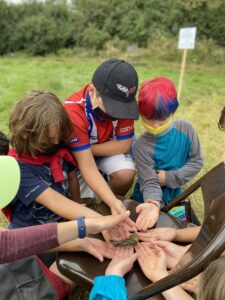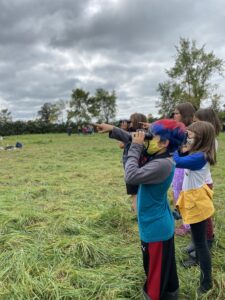Current brain research shows us that there is no such thing as an average mind. So why do traditional schools teach common curriculum, designed for an average?
At Bridge School, we teach your child as a unique learner.
We combine innovative pedagogy with a deep understanding of child development to guide each individual child’s learning. Bridge School has a proficiency based system of education that is built into the fabric of all we do. Children come to understand themselves, and their identity within a supportive community.
Who are we?

Bridge students today range in age from three to thirteen. They are:
- Compassionate community members dedicated to the advancement of their local and global community, and stewardship of the natural world.
- Exuberant scholars who pour their personal passions and critical thinking skills into academic inquiries.
- Mindful leaders who have a confident, adaptable, and resilient sense of self.
- Joyful collaborators who value diverse ideas and apply them to creative problem-solving.
- Courageous creators who express themselves through movement, theater, music, and visual arts.
Bridge teachers are:
- Empathetic mentors devoted to the holistic development of all children.
- Passionate intellectuals committed to sharing their passions and interests with students.
- Creative co-creators who help students find and be the best versions of themselves.
To learn more about who we are, visit our team page (click here).
What is the Bridge School approach?
At Bridge School, our mixed-age, close-knit, and supportive community provides the foundation for all learning. Our students develop emotional intelligence and social skills through joyfully learning and playing alongside a wide range of students. Students feel like they are part of a large family at Bridge School. We believe that when children feel supported and respected, they are naturally ready and eager to learn.

Students and teachers are engaged and challenged by meaningful, creative, hands-on learning experiences. Students attain academic achievement through collaboration and group project work as well as individual work. Our curriculum is centered around a larger, collective school goal, or theme, that changes each year based on the needs and interests of our community.
Bridge School is not limited by curriculum decisions made outside of the school. Bridge School teachers craft curriculum with an awareness of national standards, and current best practices. What makes Bridge School unique, however is our ability to blend a variety of teaching and learning approaches to meet the needs of our students.
Housed in a former dairy barn with a big blue roof and artistically painted silo, our adventures start here. Our spaces are organized around Home Centers and Collaboration Studios. Each student is assigned to a Home Center, or home base, and primary mentor/teacher. Our Collaboration Studios are the messy spaces where making occurs. Gallery walls throughout our school display and celebrate student work for all to enjoy. Frequently, our adventures extend beyond the barn into our local communities and beautiful surrounding natural landscapes.
Bridge School is philanthropically minded. We teach the importance of respecting, caring, and contributing; and our academic projects engage and support local organizations in a variety of ways.

As a small school we are nimble and flexible enough to accommodate each student’s individual learning style and goals. At Bridge, students are given choices about what and how they learn resulting in achievements always greater than expected. We are a big family, and younger and older students are encouraged to and frequently play and work together to solve problems, prepare projects, and just have fun. Our smallness also allows us to easily participate in local events and offerings, sometimes spontaneously.
Here are some things that make Bridge School different from other schools:
One of the lowest teacher-to-student ratios in the state, 1:6, consistently lower than the state average of 1:16.
There are three full-time teachers, two part-time teachers, plus parent volunteers and other adults providing instruction in specific capacities. Class sizes are small, ranging from 2-12, with six being a typical size.
Bridge School is a State Approved Independent School
Vermont statutes and State Board of Education rules authorize establishment of approved, recognized and distance learning independent schools, approved tutorials and approved educational programs. The Approved Independent School is the most rigorous classification. Details can be found here.
Bridge School is also a member of the Vermont Independent School Association. For more information about VISA’s shared values, visit here.
 All the teachers know all the students, and all the students know all the teachers
All the teachers know all the students, and all the students know all the teachers
Bridge School offers a unique environment for emotional, social, and intellectual growth. Research demonstrates the benefits of vertical continuity (the various settings in which a child receives care and education at any point in time) and horizontal continuity (the various settings over time). Bridge School teachers spend time with all students, everyday. Therefore, students create lasting relationships with their teachers throughout their years at Bridge School.
All the school’s students know each other
Because of our mix-aged classes, and school-wide practices and traditions, all the students come to know one another. Students are free to go where they choose before Morning Meeting, during silent reading, at snack, and at lunch. All students assemble together for morning and afternoon meetings. It’s not uncommon to see, for example, sixth-graders with Kindergarteners, and children of all ages in common discussion with a teacher.
Home Centers, not Home Rooms
Children stay for two or three years in the same Home Centers, in which they begin and end their day with the teacher who has oversight of their days and years. The home center is a home within the wider neighborhood of the school, a place for free play, group projects, special traditions and celebrations, serious talks and sharing, silliness, hugs, and traditions.
Acres of fun on our campus
Bridge students get a full run of our unique indoor and outdoor facilities, which include:
- Spaces for learning – Six classrooms, cataloged library, computer lab.
- Spaces for creating – Theater, workshop, art room.
- Spaces for physical education (and burning energy) – Full-size gym, regulation soccer/sports fields, indoor climbing wall, outdoor ice-skating rink, kickball field, and climbing, swinging and sliding structures.
- Spaces for exploring (and getting muddy) – Stream, small pond, tree forts, fields.
Students on the go!
Students move throughout the school during the day while teachers mostly stay put. The schedule of the day and the school year, with their special events and traditions, means that the children experience movement, ownership, and knowledge of their school home.
Kindergarten, the Sixth Grade, and the great in-between
Because Bridge School is mostly ungraded, the children nurture one another, teach each other, and contribute in an atmosphere of minimal competitiveness or fear that they may not “make the grade.” The exceptions are Kindergarten and 6th grade; the beginning and ending of Bridge School include a few special events.
Curriculum designed by your child’s teachers, not someone else
Teachers at Bridge School have opportunities to try new things for arts and explorations classes, create curriculum, games, materials, and spaces, getting to explore their own playfulness and not-knowing-ness—as the kids do. The school program is designed and decided by the classroom teachers, all of whom have strong experiences.
Curriculum Choice
We believe in developing a practice of lifelong learning. For this reason, we incorporate student choice throughout our curriculum. Student interests inform learning units, and assessment methods.
Bridge School Traditions
Over the course of more than three decades, many traditions have evolved at Bridge School, beginning with the all-school (potluck) picnic the first week of school and ending with Beach Day and 6th grade graduation. In between are Halloween, the Big Show, Winter Week, and Collar Day. The children, teachers, and parents bring their unique ideas and skills every year to these celebratory events.
